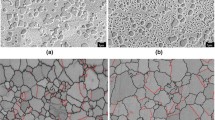Abstract
The influence of Co content on stacking fault energy (SFE) of the γ matrix in four Ni–Co base superalloys, including newly developed alloys, has been studied by utilizing high-resolution transmission electron microscopy. The results indicated the SFE was not linear with Co content of the γ matrix. The lowest SFE could be attained at around 34.0 at.% Co. This effect was attributed to variation of electron holes, saturated Co content in the matrix, and the effect of Co on the partition coefficient of other alloying elements. A high density of twins was related to low SFE and could improve the mechanical properties.







Similar content being viewed by others
REFERENCES
X.H. An, W.Z. Han, C.X. Huang, P. Zhang, G. Yang, S.D. Wu, and Z.F. Zhang: High strength and utilizable ductility of bulk ultrafine-grained Cu–Al alloys. Appl. Phys. Lett. 92, 201915 (2008).
F. Ebrahimi, Z. Ahmed, and H. Li: Effect of stacking fault energy on plastic deformation of nanocrystalline face-centered cubic metals. Appl. Phys. Lett. 85, 3749 (2004).
C.Y. Cui, Y.F. Gu, H. Harada, and A. Sato: Microstructure and yield strength of UDIMET 720Li alloyed with Co-16.9 wt pct Ti. Metall. Mater. Trans. A 36, 2921 (2005).
C.Y. Cui, Y.F. Gu, D.H. **, T. Fukuda, and H. Harada: Phase constituents and compressive yield stress of Ni-Co base alloys. Mater. Trans. 49, 424 (2008).
Y.F. Gu, T. Fukuda, C. Cui, H. Harada, A. Mitsuhashi, T. Yokokawa, J. Fujioka, Y. Koizumi, and T. Kobayashi: Comparison of mechanical properties of TMW alloys, new generation of cast-and-wrought superalloys for disk applications. Metall. Mater. Trans. A 40, 3047 (2009).
Y.F. Gu, C. Cui, H. Harada, T. Fukuda, D. **, A. Mitsuhashi, K. Kato, T. Kobayashi, and J. Fujioka: Development of Ni-Co-base alloys for high-temperature disk applications, in Proceedings of the Eleventh International Symposium on Superalloys (Pennsylvania, PA, September 14–18, 2008, The Minerals, Metals and Materials Society, USA, 2008), p. pp53.
Y. Yuan, Y.F. Gu, C.Y. Cui, T. Osada, T. Yokokawa, and H. Harada: A novel strategy for the design of advanced engineering alloys—strengthening turbine disk superalloys via twinning structures. Adv. Eng. Mater. 13, 296 (2011).
Q. Yu, Z.W. Shan, J. Li, X. Huang, L. **ao, J. Sun, and E. Ma: Strong crystal size effect on deformation twinning. Nature 463, 335 (2010).
B.B. Rath, M.A. Imam, and C.S. Pande: Nucleation and growth of twin interfaces in fcc metals and alloys. Mater. Phys. Mech. 1, 61 (2000).
T.H. Blewitt, P.R. Coltman, and J.K. Redman: Low-temperature deformation of copper single crystals. J. Appl. Phys. 28, 651 (1957).
G.T. Gray III: Deformation twinning in Al-4.8 wt% Mg. Acta Metall. 36, 1745 (1988).
J.G. Zheng, Q. Li, Z.G. Liu, D. Feng, and G. Frommeyer: Complex stacking fault energy of Cr-alloyed γ-TiA1. Phys. Lett. A 196, 125 (1994).
L.C. Qin, D.X. Li, and K.H. Kuo: An HRTEM study of the defects in ZnS. Philos. Mag. A 53, 543 (1986).
Z.L. Zhang, W. Sigle, and W. Kurtz: HRTEM and EELS study of screw dislocation cores in SrTiO3. Phys. Rev. B 69, 144103 (2004).
R.J. Hebert, J.H. Perepezko, H. Rösner, and G. Wilde: Dislocation formation during deformation-induced synthesis of nanocrystals in amorphous and partially crystalline amorphous Al88Y7Fe5 alloy. Scr. Mater. 54, 25 (2006).
S.J. Zhou, D.L. Preston, P.S. Lomdahl, and D.M. Beazley: Large-scale molecular dynamics simulations of dislocation intersection in Copper. Science 279, 1525 (1998).
E. Aerts, P. Delavignette, R. Siems, and S. Amelinckx: Stacking fault energy in silicon. J. Appl. Phys. 33, 3078 (1962).
C. Feng and B.S.J. Kang: A transparent indenter measurement method for mechanical property evaluation. Exp. Mech. 46, 91 (2006).
J.A. Lee: Effects of the density of states on the stacking fault energy and hydrogen embrittlement of transition metals and alloys, in Proceedings of the 2008 International Hydrogen Conference (Grand Teton Natl. Park, WY, September 7–10, 2008), p. 678.
X.L. Nie, R.H. Wang, Y.Y. Ye, Y.M. Zhou, and D.S. Wang: Calculations of stacking fault energy for fcc metals and their alloys based on an improved embedded-atom method. Solid State Commun. 96, 729 (1995).
X.S. **e, G.L. Chen, P.J. Mchugh, and J.K. Tien: Including stacking fault energy into the resisting stress model for creep of particle strengthened alloys. Scr. Metall. 16, 483 (1982).
Z.A. Yang, Y.T. **ao, and C.X. Shi: The role of cobalt in the high temperature creep of γ’-strengthened nickel-based superalloys. Mater. Sci. Eng., A 101, 65 (1988).
I.R. Harris, I.L. Dillamore, R.E. Smallman, and B.E.P. Beeston: The influence of d-band structure on stacking fault energy. Philos. Mag. 14, 325 (1966).
L. Pauling: The nature of the interatomic forces in metals. Phys. Rev. 54, 899 (1938).
X.X. Yu and C.Y. Wang: The effect of alloying elements on the dislocation climbing velocity in Ni: A first-principles study. Acta Mater. 57, 5914 (2009).
R.G. Barrows and J.B. Newkirk: A modified system for predicting s formation. Metall. Trans. 3, 2889 (1972).
A.A. Ogwu and T.J. Davies: Effect of the electronic state, stoichiometry and ordering energy on the ductility of transition metal-based intermetallics. J. Mater. Sci. 28, 847 (1993).
T.C. Schulthess, P.E.A. Turchi, A. Gonis, and T.G. Nieh: Systematic study of stacking fault energies of random Al-based alloys. Acta Mater. 46, 2215 (1998).
ACKNOWLEDGMENTS
The authors thank Prof. L.C. Qin at University of North Carolina, Chapel Hill, NC, for discussion and help to conduct HRTEM experiments. Y. Yuan is indebted to Dr. T. Nagai for the lecture of JEM 2100F at National Institute for Materials Science, Japan.
Author information
Authors and Affiliations
Corresponding author
Rights and permissions
About this article
Cite this article
Yuan, Y., Gu, Y., Cui, C. et al. Influence of Co content on stacking fault energy in Ni–Co base disk superalloys. Journal of Materials Research 26, 2833–2837 (2011). https://doi.org/10.1557/jmr.2011.346
Received:
Accepted:
Published:
Issue Date:
DOI: https://doi.org/10.1557/jmr.2011.346




